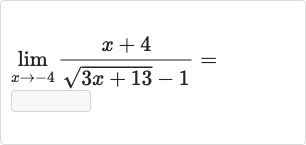AI tutor
Full solution
Q.
- Identify Function & Point: Identify the function and the point at which we need to find the limit.We have the function and we need to find the limit as approaches .
- Substitute : Substitute into the function to see if the limit can be directly calculated.We encounter an indeterminate form , which means we cannot directly calculate the limit.
- Apply Algebraic Manipulation: Apply algebraic manipulation to eliminate the indeterminate form. We can multiply the numerator and the denominator by the conjugate of the denominator to rationalize it. The conjugate of is .
- Multiply by Conjugate: Multiply the function by the conjugate over itself.
- Apply Difference of Squares: Apply the difference of squares formula to the denominator.The difference of squares formula is .
- Simplify Denominator: Simplify the denominator.
- Cancel Common Factors: Cancel out the common factor of in the numerator and the factor of in the denominator.
- Substitute : Substitute into the simplified function to find the limit.
More problems from Domain and range of square root functions: equations
QuestionGet tutor help
QuestionGet tutor help

